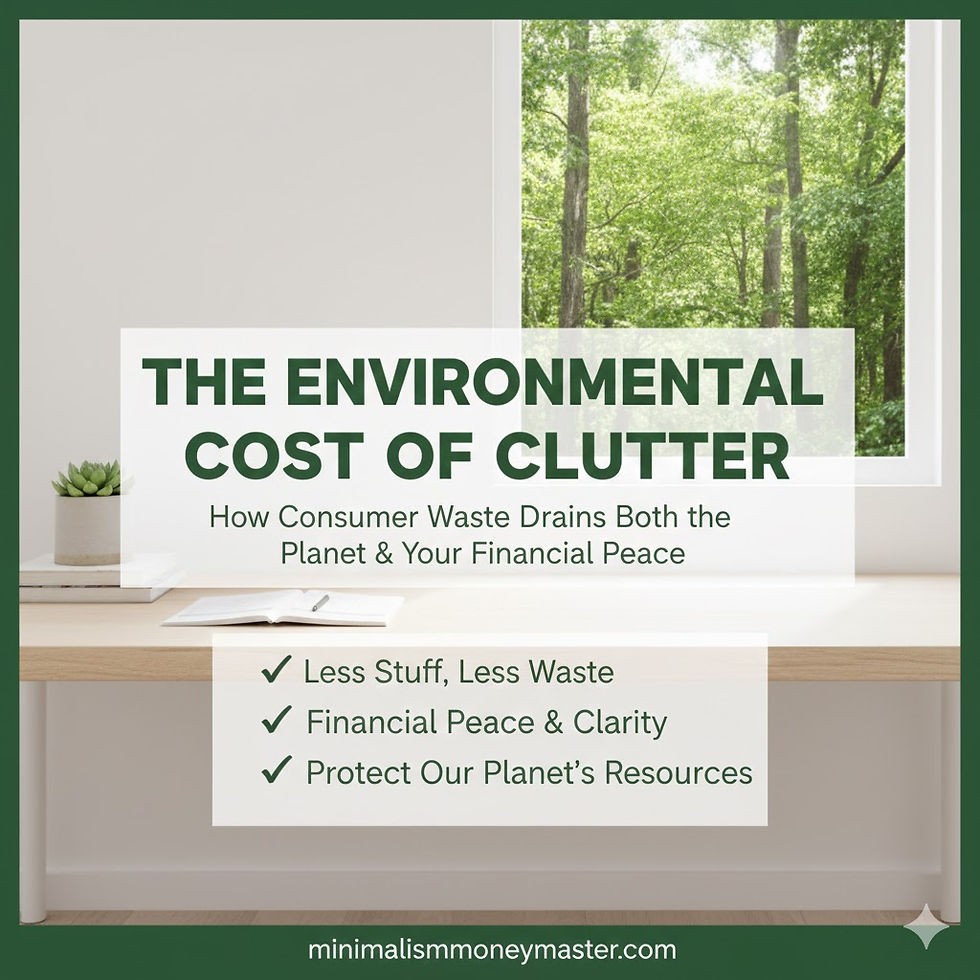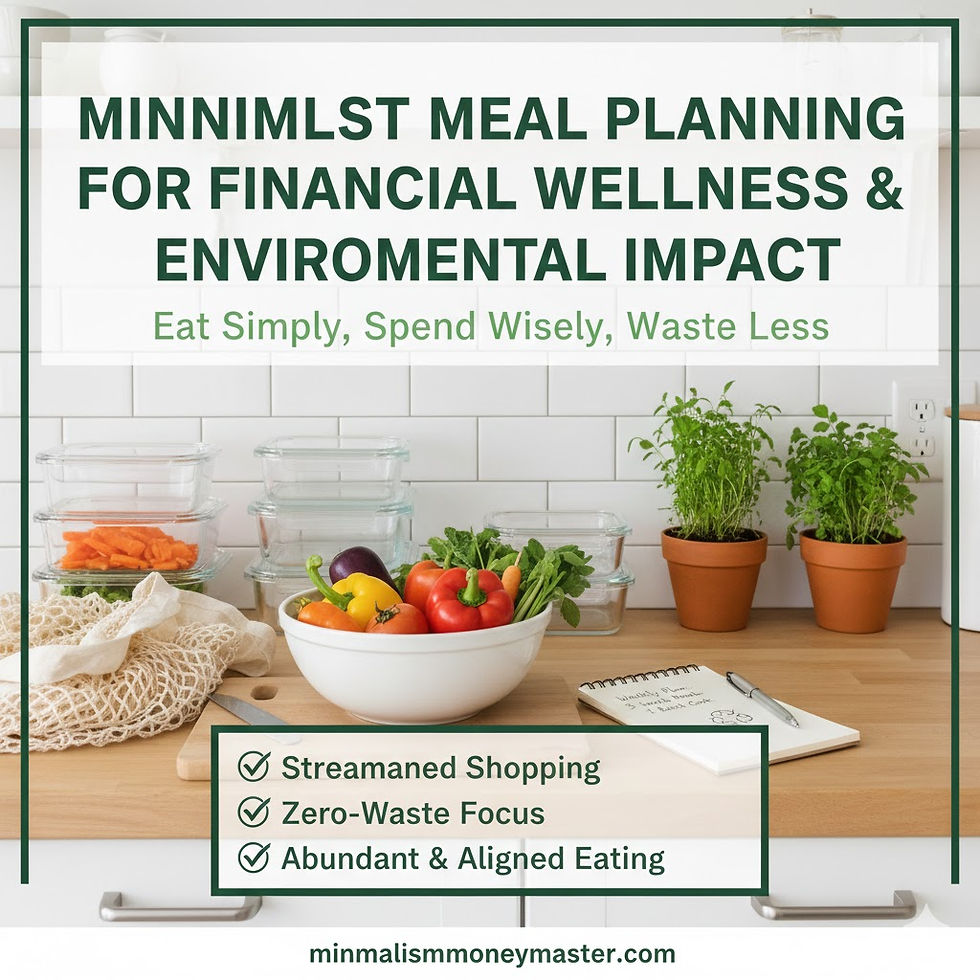Designing a Minimalist Tiny Home Financial Plan: Strategy, Costs, and ROI
- jennifercorkum
- Oct 21
- 6 min read
The tiny home movement has captured imaginations around the world. People are downsizing, simplifying, and living intentionally. But while the lifestyle images — cozy cabins, minimal clutter, scenic views — are compelling, the real power of tiny homes lies in the numbers.
When approached strategically, tiny homes can become a financial engine: reducing expenses, accelerating savings, and supporting long-term wealth-building. But to achieve this, you need more than inspiration. You need a clear financial plan that integrates cost structure, financing strategy, return on investment (ROI), and broader life goals.
In this post, we’ll explore how to design a minimalist financial plan for a tiny home, combining disciplined budgeting, smart financing, and intentional strategy — so that your tiny home works for you financially, not against you.
Step 1: Understand the Real Cost Structure of a Tiny Home
Tiny homes are often touted as “cheap housing,” but costs can vary widely depending on your choices. A minimalist approach doesn’t mean cutting corners — it means understanding exactly where money goes and allocating it intentionally.
1. Land Costs
A tiny home has to sit somewhere. Your options include:
Owning land outright — offers long-term control but requires upfront capital and may involve site preparation costs.
Leasing or renting land — flexible but introduces monthly costs.
Placing the home in a tiny home community or RV park — typically involves lot rent or membership fees.
Minimalist tip: Choose land based on your long-term financial goals, not just aesthetics. Rural plots may be cheaper but may lack utilities. Urban-adjacent land may cost more but offer better services and resale value.
2. Construction Costs
Tiny home build costs typically range from $30,000 to $100,000, depending on:
DIY vs. professional build
Materials used (standard vs. premium)
Size and layout
Energy systems (grid-tied, off-grid, solar, etc.)
DIY builds can save tens of thousands, but they require time, skills, and realistic budgeting. Prefab models offer predictability but may limit customization. Custom professional builds offer flexibility but can creep into traditional home price territory if not managed carefully.
Minimalist tip: Stick to essential features and durable materials. Avoid over-customizing — the goal is functional simplicity, not recreating a mansion on wheels.
3. Utility and Infrastructure Costs
Even if the house is small, hooking up utilities can be expensive. Consider:
Water and septic systems
Electricity or solar setups
Heating/cooling systems
Internet access (especially if you work remotely)
If going off-grid, factor in battery storage, water filtration, and maintenance. A minimalist plan acknowledges these upfront costs to avoid surprises.
4. Legal and Zoning Costs
Zoning and permitting can add both financial and time costs. Some areas have minimum square footage requirements or restrictions on where tiny homes can be placed.
Minimalist tip: Do your legal due diligence early. A few hundred dollars spent on consultations or permits can save thousands in fines or relocations later.
Step 2: Choose Financing Intentionally — Avoid Debt Traps
One of the biggest financial advantages of tiny homes is the potential to avoid or minimize mortgage debt. But this requires a smart financing strategy.
Option 1: Pay Cash
The cleanest option — no debt, no interest, full ownership from day one. For many tiny home buyers, the lower price point makes this realistic, especially if you’ve saved intentionally or sold a larger property.
Pros:
No monthly payments
Total flexibility
Lower long-term costs
Cons:
Large upfront outlay may reduce investment liquidity
Minimalist view: If you can pay cash without draining your emergency fund or investment core, this is the most financially liberating route.
Option 2: Personal or RV Loans
Many tiny homes (especially on wheels) qualify for personal loans or RV loans. These typically have shorter terms (5–15 years) and may carry higher interest rates than traditional mortgages.
Pros:
Faster access without needing full cash
Shorter loan duration than 30-year mortgages
Cons:
Higher interest rates than secured mortgages
Monthly payments can limit savings rate if not managed carefully
Minimalist view: Use loans sparingly and strategically. If you must borrow, choose the shortest term you can comfortably afford, and prioritize paying it off early.
Option 3: Land + Structure Financing
In some cases, you can combine land and tiny home financing, especially for permanent foundations. This may qualify for more traditional loans, but typically involves more paperwork and regulations.
Minimalist view: This can make sense if the land has strong long-term value, but be cautious of overleveraging. The goal is financial freedom, not replacing a McMansion mortgage with a smaller one.
Step 3: Identify Your Tiny Home ROI Model
Tiny homes can generate ROI in multiple ways — not just through cost savings. A minimalist financial plan identifies your primary ROI model and builds around it.
Model 1: Personal Residence Savings
The simplest model: live in your tiny home, spend less, and redirect savings toward investments, debt payoff, or lifestyle goals.
For example, if downsizing saves you $1,500 per month in mortgage and utility costs, that’s $18,000 per year. Invested consistently, this can compound into hundreds of thousands over time.
Model 2: Rental Income
Some owners build or buy tiny homes to rent out on:
Airbnb/short-term platforms for vacation rentals.
Long-term rentals as affordable housing units or accessory dwelling units (ADUs).
Tiny homes can yield strong rental returns relative to cost, especially in tourist areas or housing-constrained cities. But this requires careful management of regulations and maintenance.
Minimalist tip: Choose this model only if you want to run it like a business, not a hobby. Simplicity comes from structure, not spontaneity.
Model 3: Mobility and Location Arbitrage
Tiny homes on wheels unlock geographic flexibility. By relocating seasonally or strategically, you can:
Live in lower-cost-of-living areas
Avoid high property taxes or HOA fees
Position near temporary job opportunities or travel routes
This flexibility can dramatically reduce living expenses while maintaining lifestyle quality.
Step 4: Integrate Tiny Homes Into Your Broader Financial Goals
A tiny home isn’t a standalone decision — it’s a strategic piece of your overall minimalist financial plan.
Here’s how it can fit:
Accelerating FI (Financial Independence): Lower housing costs → higher savings rate → earlier retirement or semi-retirement.
Supporting remote work or self-employment: Lower monthly expenses reduce pressure, giving you more freedom to pursue flexible income.
Reducing lifestyle inflation: Smaller spaces naturally limit excessive consumption, keeping your financial trajectory lean.
Building optionality: Owning a tiny home gives you a safety net — a place to live with minimal expenses, even during income fluctuations.
Minimalism is about designing systems that quietly work in your favor. A tiny home can become one of those systems if you align it with clear financial goals.
Step 5: Avoid Common Financial Pitfalls
Tiny homes can be financially powerful — but only if you avoid the traps that catch many new builders and buyers.
❌ Zoning Oversight: Building without checking local regulations can lead to expensive relocations or fines.
❌ Overbuilding: Adding unnecessary features pushes costs up without increasing value. Keep it simple and functional.
❌ Ignoring Utilities: Hookup and infrastructure costs can rival or exceed the home itself if not planned.
❌ Romanticizing ROI: Don’t assume Airbnb riches or resale booms — run conservative numbers and base your plan on real data.
❌ Neglecting Exit Strategy: Life changes. Make sure your tiny home can be sold, relocated, or repurposed if needed.
Bringing It All Together
A tiny home can be more than a lifestyle choice. With a minimalist financial plan, it becomes a powerful strategic asset — lowering expenses, enabling flexibility, and supporting long-term wealth building.
The key is to treat it with the same seriousness you’d bring to any major financial decision:
Understand costs clearly and upfront.
Finance intentionally, avoiding unnecessary debt.
Choose your ROI model deliberately.
Integrate the decision into your broader financial independence plan.
Avoid pitfalls with research and disciplined execution.
Final Thought
Tiny homes are often portrayed as whimsical, even rebellious. But from a minimalist finance perspective, they’re something better: a quiet, strategic way to reshape your financial life.
Whether you’re seeking financial freedom, mobility, or a simpler lifestyle, a well-designed tiny home financial plan can turn housing from a burden into a wealth-building tool.
Minimalism turns good ideas into disciplined systems.A tiny home, backed by a solid financial plan, is exactly that kind of system.







Comments